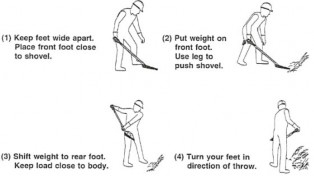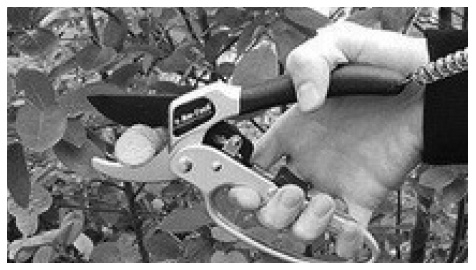Lawn Care: Hand Tools Safety
ID
BSE-40NP (BSE-98P)
Objective: To promote the safe use of hand tools.
How to Use This Training Module – Steps to Success
Read the operator’s manual and understand hand tool operation and safe practices..
Ask your supervisor to point out the safety
features on different hand tools.
Ask your supervisor to demonstrate the safe use of hand tools and their maintenance.
Become familiar with personal protective equipment (PPE) and understand when different types are to be used.
Discuss common accidents that can occur during the use of hand tools and ways to prevent them with your supervisor.
Review the important points in the Review section of this module.
Take a quiz — available at http://connect.ag.vt.edu/safe-htools — to check your understanding of hand tools safety.
Background
Many hand tools such as shovels, hoes, rakes, trimmers, and pruners are widely used in lawn care and landscaping. While these tools appear to be harmless, when used improperly, they can cause injuries that sometimes require medical treatment. In 2006, the U.S. Bureau of Labor Statistics reported nearly 205,000 cases of injuries and/or illnesses resulting from the use of hand tools.
Often, workers use unsafe postures and take shortcuts in the interest of saving time, but the extra time spent in getting a job done without injury is always time well-spent. Tools should never be used above shoulder height. Operators who are careful will recognize when they use unsafe postures and practices. The use of personal protection equipment such as safety glasses and sturdy work gloves and footwear is extremely important for protecting workers.
Tips for Personal Safety

Protect yourself from the sun, heat, insect bites or stings, and moving vehicles.
Consume adequate amount of water to avoid dehydration.
Take frequent breaks in the shade during warm weather.
Notify the crew leader of injury and seek medical assistance promptly.
Rake Safety Tips
- Choose a rake of appropriate size — depending on the size and strength of the user — to allow for ease of use.
- Do not reach too far out — either with the rake or by stretching your back — when raking.
- Stay in an upright position and use shorter raking strokes instead of long, reaching strokes.
- Switch the position of your hands on the rake handle and alternate hands periodically.
Shoveling Safety Tips

- Choose the proper shovel for the job, keeping in the mind the size and strength of the user.
- Never underestimate the weight of soil.
- Use proper posture when shoveling.
Pruning Safety Tips

- Always wear safety glasses and gloves when using a pruner.
- Always use a tripod ladder when pruning shrubs and vines located higher up or when using a hand pruner in an orchard.
- Never carry a tool up or down a ladder.
- Never use a pruner on large branches.
- Ensure that the pruner blade is sharp to make the cut quickly and easily.
Tips for Cleaning and Maintenance
Hand Tool Cleaning Tips
- Always clean tools after use.
- Tools can be washed using a hose and nozzle and/or scrubbed with a wire brush.
- Minimize the risk of spreading germs when washing dirty tools.
- Spray light oil like WD-40 on areas prone to rust.
Hand Tool Maintenance Tips
- Keep metal blades sharp and well-oiled.
- Check nuts, bolts, rivets, screws, blades, and springs regularly for wear or damage; replace if necessary.
- Sand all wooden parts regularly and coat them with a 50/50 linseed oil and turpentine mixture.
- Label and store damaged tools in a designated area and notify the supervisor or the maintenance person.
Review
Always wear PPE appropriate for the task.
Stay in an upright position when raking and use shorter strokes instead of long, reaching strokes.
Never carry a tool up or down a ladder.
Always clean tools after use.
Selecting the right shovel for the job and maintaining proper posture during shoveling are very important.
Acknowledgements
This publication was developed with the support of National Youth Farm Safety Education and Certification (grant No. USDA/NIFA- 2010-41521-20830), National Institute of Food and Agriculture, and the U.S. Department of Agriculture. The team that developed this publication is solely responsible for its content; it does not necessarily reflect the views of the U.S. Department of Agriculture or the U.S. Department of Labor. Team members are Robert Grisso, John Perumpral, Don Ohanehi, Mike Goatley, Kathleen Jamison, Cathy Sutphin, Dan Swafford, and Carl Estes.
The team would like to express appreciation for the reviews and comments by David Balderson, teacher, Atlee High School; Phil Blevins, Virginia Cooperative Extension agent; Deborah Chaves, instructor, Monroe Technology Center; Sonya Furgurson, VCE associate agent; Michael Hopkins, instructor, Louisa High School; Emerson Lynn “Kip” Kirby Jr., teacher, Richlands High School; Michael Lachance, VCE agent; Alyssa Walden, VCE associate agent; A.J. Powell Jr., professor emeritus, University of Kentucky.
Virginia Cooperative Extension materials are available for public use, reprint, or citation without further permission, provided the use includes credit to the author and to Virginia Cooperative Extension, Virginia Tech, and Virginia State University.
Virginia Cooperative Extension is a partnership of Virginia Tech, Virginia State University, the U.S. Department of Agriculture, and local governments. Its programs and employment are open to all, regardless of age, color, disability, sex (including pregnancy), gender, gender identity, gender expression, national origin, political affiliation, race, religion, sexual orientation, genetic information, military status, or any other basis protected by law
Publication Date
January 30, 2024



